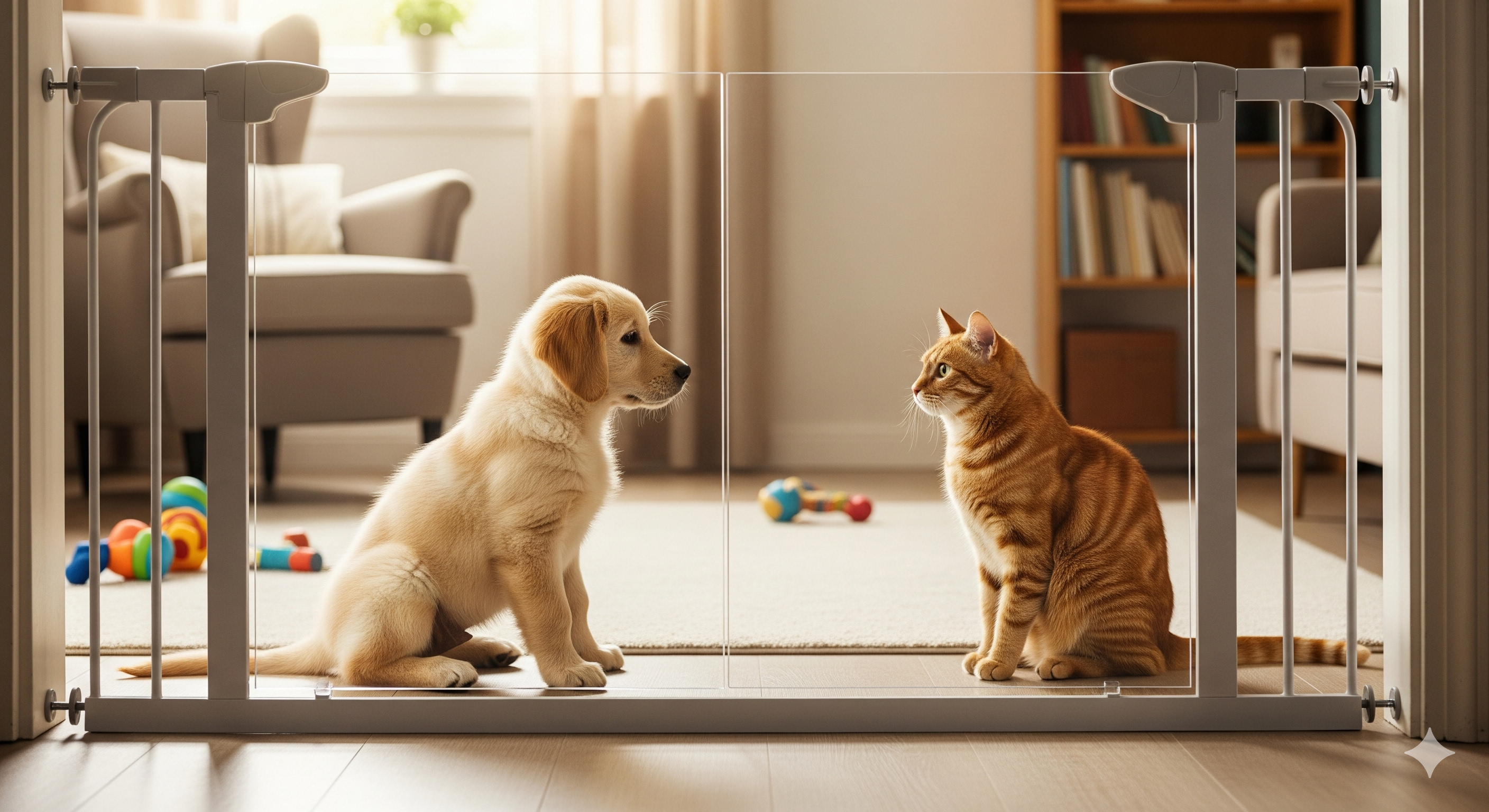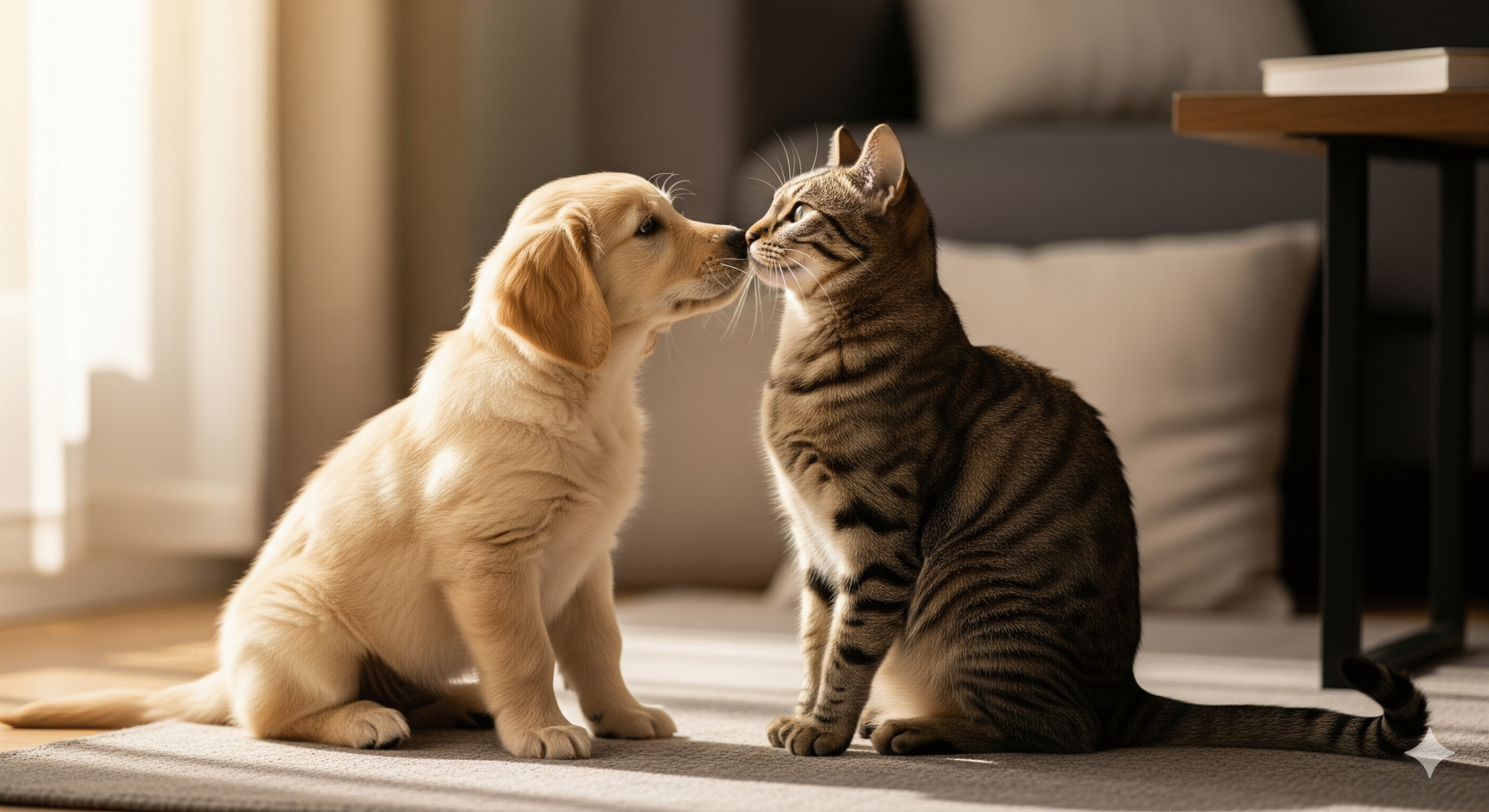The image of a dog and cat living together in perfect harmony is a classic ideal, but the reality of introducing a bouncy, curious puppy to a dignified, territorial cat can feel more like a recipe for disaster. Your resident cat views your home as their kingdom, and a new puppy is a loud, unpredictable invader. A poorly managed introduction can lead to lasting fear, aggression, and stress for both animals.
However, with a patient, strategic approach, you can successfully foster a peaceful—or even friendly—relationship between your puppy and cat. This isn’t about forcing them to be best friends; it’s about teaching them to respect each other and coexist safely under one roof.
This definitive guide will provide a proven, step-by-step process to ensure that first introduction sets the stage for a harmonious multi-pet household. We’ll cover:
✔️ Pre-introduction preparation to set both pets up for success
✔️ The importance of scent swapping before any visual contact
✔️ A detailed, gradual introduction process using barriers and controlled exposure
✔️ How to read both puppy and cat body language to prevent conflicts
✔️ Managing your home for long-term peace and safety
Let’s ensure your puppy’s homecoming is the start of a beautiful, if cautious, friendship.
Before You Begin: Understanding the Challenge 🧠
- The Cat’s Perspective: Your cat sees a loud, chaotic predator with no understanding of personal space. Their primary instincts are to flee, hide, or defend their territory.
- The Puppy’s Perspective: Your puppy sees a fascinating, fast-moving, potentially fun new “toy” to chase and play with. They don’t understand that their playful advances are terrifying.
- The Goal: Managed indifference. The ideal outcome is that both animals feel safe and secure, ignoring each other without fear or excitement.
Step 1: Pre-Introduction Preparation & Setup 🏠
Success is determined by your setup before the pets ever meet.
Create a “Safe Room” for Your Cat 🐈
- Designate a quiet room (a bedroom or office) as the cat’s sanctuary.
- Equip it with all their essentials: litter box, food, water, a comfortable bed, and a high perch (like a cat tree or shelf).
- Use a sturdy door or a tall baby gate that the cat can jump over but the puppy cannot (you may need to add a mesh screen).
Prepare Your Puppy 🐕
- Ensure your puppy has had plenty of exercise and a potty break before any introduction steps. A tired puppy is a calmer puppy.
- Practice basic obedience commands like “sit,” “stay,” and “leave it.” These will be crucial for managing interactions.
Set Up Your Home for Success 🔒
- Install baby gates to create puppy-free zones.
- Provide high escape routes for your cat, such as cat trees, shelves, and furniture they are allowed on.
- Ensure your cat’s litter box and food bowl are in a location completely inaccessible to the puppy.
Step 2: The Power of Scent Swapping
The first introduction should be through smell, not sight.
- Swap Bedding: Place a blanket or towel that your puppy has slept on in your cat’s safe room (away from their food/litter). Do the same for the puppy with the cat’s bedding.
- Exchange Scents: Rub a clean sock or soft cloth on one animal’s cheeks (where scent glands are) and let the other animal sniff it. Pair this with treats and praise for both.
- Feed on Opposite Sides of the Door: Feed the cat and the puppy their meals on opposite sides of the safe room door. This builds a positive association with each other’s smell.
Progress to the next step only when both animals are calm and curious about the other’s scent, not hissing, growling, or fearful.
Step 3: Controlled Visual Introductions 👀
Once they are comfortable with scent, allow them to see each other without the risk of contact.
- Use a Baby Gate or Screen Door: The safest method is to use a secure baby gate or a transparent screen door on the safe room.
- The First Look: Keep the puppy on a leash and at a distance from the gate. Allow the cat to approach the gate if they choose. Reward both animals with high-value treats for calm behavior.
- Keep Sessions Short: Start with just a few minutes at a time, multiple times a day.
- Manage the Puppy’s Energy: If the puppy gets too excited, lunges, or barks, calmly increase the distance from the gate and ask for a “sit.” Reward calm behavior. Do not punish.
Step 4: Supervised Face-to-Face Meetings 🤝
This is the final stage and should only be attempted after many successful visual sessions.
- Leash the Puppy: Keep the puppy on a leash for full control.
- Let the Cat Set the Pace: Allow the cat to enter the room and approach if they want. They should always have an easy escape route.
- Use Commands: Ask your puppy to “sit” and “stay.” Reward them heavily for ignoring the cat.
- Watch Body Language Closely:
- Good Cat Signs: Relaxed posture, slow blinking, ignoring the puppy.
- Bad Cat Signs: Hissing, growling, flattened ears, puffed-up tail, staring.
- Good Puppy Signs: Calm sitting, loose body, glancing away.
- Bad Puppy Signs: Stiff posture, staring, whining, lunging.
- End on a Positive Note: Keep the first meeting very short (under a minute) and end with treats and praise for both pets before any tension arises.
Reading Their Body Language: A Quick Guide 🚦
Green Lights (All Good!) ✅
- Cat: Ignores the puppy, slow blinks, grooms itself.
- Puppy: Glances at the cat then looks away, offers a play bow but doesn’t chase.
Yellow Lights (Proceed with Caution) ⚠️
- Cat: Stares intently, flicks tail, crouches.
- Puppy: Stares, whines, gets a “stalky” posture.
Red Lights (Intervene Immediately!) 🚨
- Cat: Hissing, growling, swatting, ears fully flattened.
- Puppy: Lunging, barking, full-on chasing.
To Intervene: Calmly redirect the puppy with a treat or toy and create more space. Never yell or punish, as this increases everyone’s stress.
Long-Term Management for a Peaceful Home 🕊️
- Never Force Interaction: Let their relationship develop at their own pace. They may never be cuddle buddies, and that’s okay.
- Continue Providing Escape Routes: High perches and puppy-free zones are forever.
- Supervise Until Fully Trusted: Never leave them alone together until you are 100% confident in their interactions. This can take weeks or months.
- Play with Your Puppy: A well-exercised puppy is less likely to pester the cat.
What NOT to Do ❌
🚫 Never hold your cat up to the puppy. This is terrifying for the cat and removes their ability to flee.
🚫 Do not scold your cat for hissing. This is a normal warning signal. Punishing it will only make your cat more stressed.
🚫 Don’t rush the process. Going too fast will ruin weeks of progress.
Final Checklist for Success ✅
☑️ Cat has a designated safe room with all essentials.
☑️ Scent swapping has been completed successfully.
☑️ Visual introductions through a barrier are calm and positive.
☑️ Puppy knows basic obedience commands.
☑️ You can identify signs of stress and calm in both animals.







